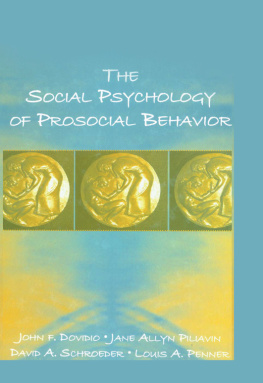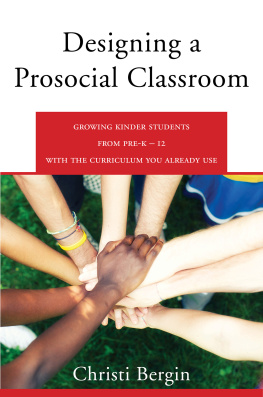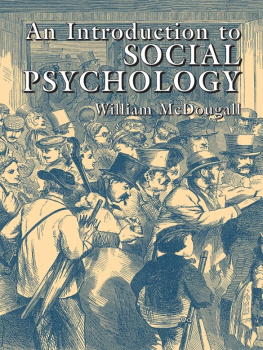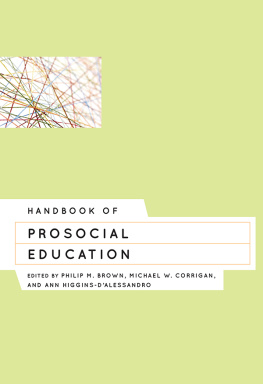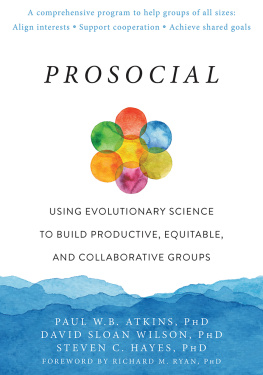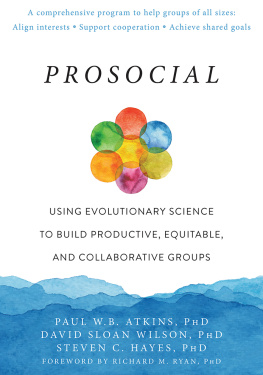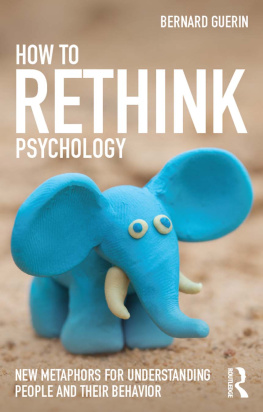This edition published 2012 by Psychology Press
Psychology Press
Taylor & Francis Group
711 Third Avenue,
New York, NY 10017
Psychology Press
Taylor and Francis Group
27 Church Road
Hove
East Sussex BN3 2FA
2006 by Taylor & Francis Group, LLC
Originally published by Lawrence Erlbaum Associates
Reprinted in 2009 by Psychology Press, an imprint of Taylor & Francis Group
10 9 8 7 6 5 4 3
International Standard Book Number-13: 978-0-8058-4935-6
Library of Congress catalog number: 2005057453
Cover art: Good Samaritan bronze medal by Donal Hord. Courtesy Special Collections, San Diego Public Library. Cover Design by Tomai Maridou
Except as permitted under U.S. Copyright Law, no part of this book may be reprinted, reproduced, transmitted, or utilized in any form by any electronic, mechanical, or other means, now known or hereafter invented, including photocopying, microfilming, and recording, or in any information storage or retrieval system, without written permission from the publishers.
Trademark Notice: Product or corporate names may be trademarks or registered trademarks, and are used only for identification and explanation without intent to infringe.
Library of Congress Cataloging-in-Publication Data
Catalog record is available from the Library of Congress
Visit the Taylor & Francis Web site at
http://www.taylorandfrancis.com
and the Psychology Press Web site at
http://www.psypress.com
Preface
This book is dedicated to our families: Linda, Alison, and Michael Irv, Allyn, Libby, Maasai, Isaac, and N'Dea Susie, Lisa, and Kevin Teri, Charles, and Ellen
To our spousesfor their patience, support, encouragement, and love; and to our children and grandchildrenfor being constant reminders of what is really important in this life and why we need to understand how to make the world a better, more helpful place.
This book did not turn out the way we expected it would. Perhaps we had listened too much to colleagues who kept asking, Why are you writing another book on prosocial behavior? There is not much new there. So our original plan was simply to write a new, updated version of our 1995 volume, The Psychology of Helping and Altruism: Problems and Puzzles. However, as we started to work on the project, something we had suspected became quite evident to usthere have been many significant new developments in the area of prosocial behavior. There is indeed not much new on the traditional topic of spontaneous interpersonal helpingor bystander intervention. It is no longer the hot topic it was in the 1960s and 1970s, when it was one of the dominant research areas in social psychology. Although work in this area has continued to evolve, it is an empirically and conceptually mature area. It may even have reached the state in which we can say that no more work is needed! Perhaps in contrast to the rapid and profound developments of earlier times, the more recent developments on other topic areas have happened at a much slower pace, but they were happening nonetheless.
Thus, as we began the task of updating our earlier book, it became obvious that the study of prosocial behavior was not what it was 30 years ago, or even 10 years ago when our first book on helping and altruism was published. In fact, it is much more exciting today. Although once research on the topic was narrow, focusing on the particular phenomenon of one-on-one helping with strangers, it is now more multidimensional, encompassing a wide range of phenomena including volunteering, blood donation, actions to assist organizations and other people within those organizations, whistle blowing to prevent organizations from causing harm, and cooperation within and between groups. The field has also changed dramatically in theoretical scope. Most of the previous theoretical emphasis was on interpersonal processes (what we have labeled meso-level processes), but most of the new conceptual breakthroughs have involved, on the one hand, work in more micro-level processes related to behavioral genetics and neuroscience and, on the other hand, research in more macro-level processes related to planned and sustained actions for or within organizations and prosocial behavior within and between groups. Although the study of helping formerly was primarily the province of social psychologists, it is now of interest to geneticists, biologists, neuroscientists, evolutionary psychologists, economists, sociologists, and political scientists.
Thus, the current book is not our old book sprinkled with new references. We still have spontaneous interpersonal helping as an important focus of the volume, and we have retained and updated some sections of the coverage of the 1995 book. However, this book is significantly different from the previous volume in both style and substance. First, stylistically, the current book is more focused on the central themes, containing fewer photographs, cartoons, and boxes. The study of prosocial behavior is a fascinating story, and we let the work speak more for itself. Still, we have tried to present this story with a writing style that will appeal and be accessible to lay readers, undergraduates, graduate students, and professionals in a broad range of disciplines. Second, the research discussed in the book reflects the most recent developments in the field. Forty percent of the references were published since 1995, the year in which the previous book was published.
Third, and most fundamentally, the current book is organized differently and has a decidedly different emphasis than the 1995 volume. It builds systematically from micro-level processes through meso-level processes to macro-level processestaking the multilevel perspective that we introduced in our recent Annual Review of Psychology article (Penner, Dovidio, Piliavin, & Schroeder, 2005). The traditional topic of spontaneous, interpersonal helping is still important, but it now shares the limelight much more with planned, sustained, and collective forms of prosocial behavior. Thus, the conceptual and empirical scope of the present book is much broader than our earlier efforts. And we believe it shows that the conventional wisdom that there is not much new to say about prosocial behavior is, quite simply, wrong.
This volume has important personal significance for us. Each of us has been a contributing scholar in this area for over 30 years. Chronologically, philosophically, and professionally, the authors of this book are all in some ways children of the '60s. In the 1960s, Jane Piliavin had already embarked on her academic career. But it was during this time that she began a career-long program of research on prosocial behavior, including the study of helping in emergencies and long-term prosocial actions such as blood donations. The other authors were students in the 1960s who read the emerging work on helping during that period and were fascinated by it, but we approached the topic from different perspectives. Lou Penner studied prosocial behavior from an individual-difference perspective, asking questions about what personality characteristics differentiate helpers from nonhelpers. Jack Dovidio began his career studying social connections that promote helping and then used helping as a means to study racial attitudes and intergroup relations. Dave Schroeder studied how to make individuals and members of groups more cooperative and helpful even when it might be to their immediate benefit to be selfish. We did not know one another as we began our work on these issues and were literally spread from coast to coast. Despite these differences, all of us shared one very important thing in common: We all saw studying helping and other prosocial actions as a way to incorporate our social interests and concerns into the research that we conducted. It was our common research interests that brought us together, first as professional acquaintances, then as coauthors and co-investigators, then, perhaps most importantly, as friends. Over the years, we have published together in many different combinations. However, as this book illustrates, we have an enduring relationship with each other and a sustained commitment to the study of prosocial behavior as a social force.

